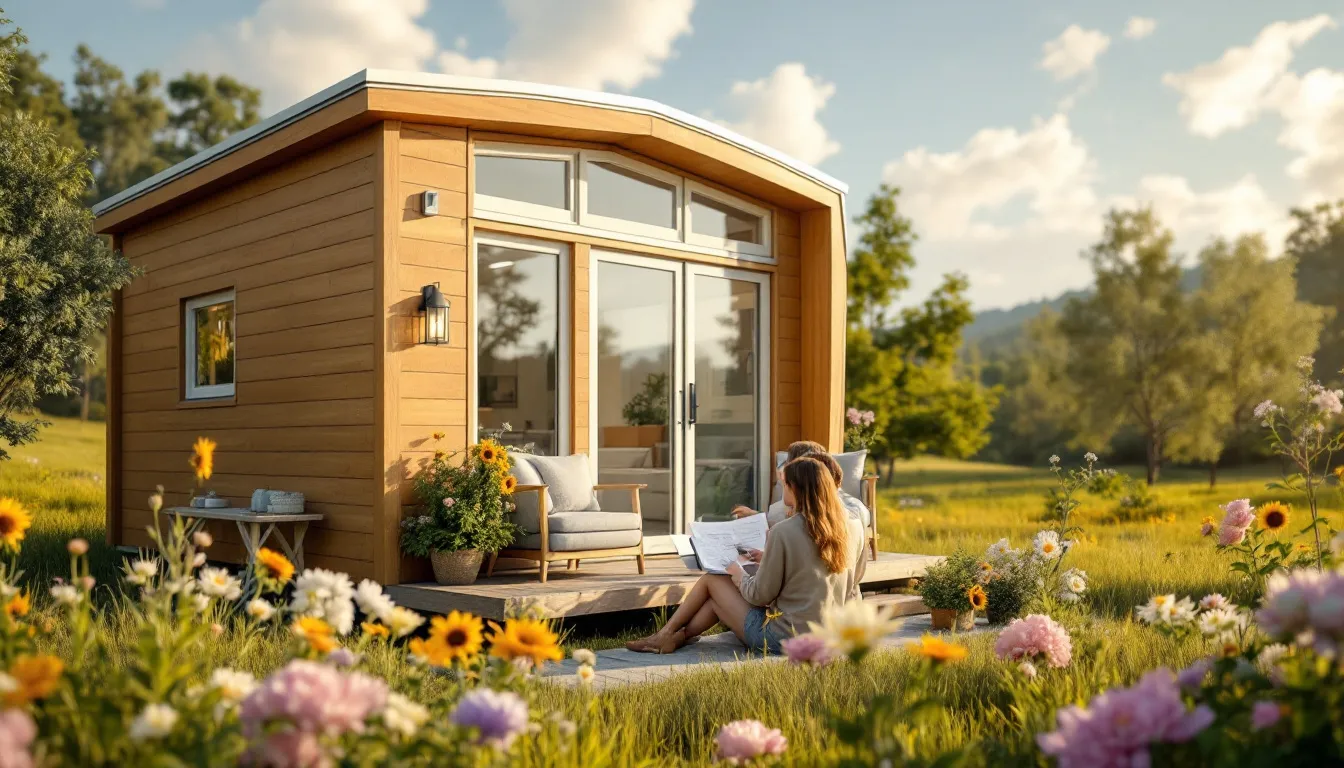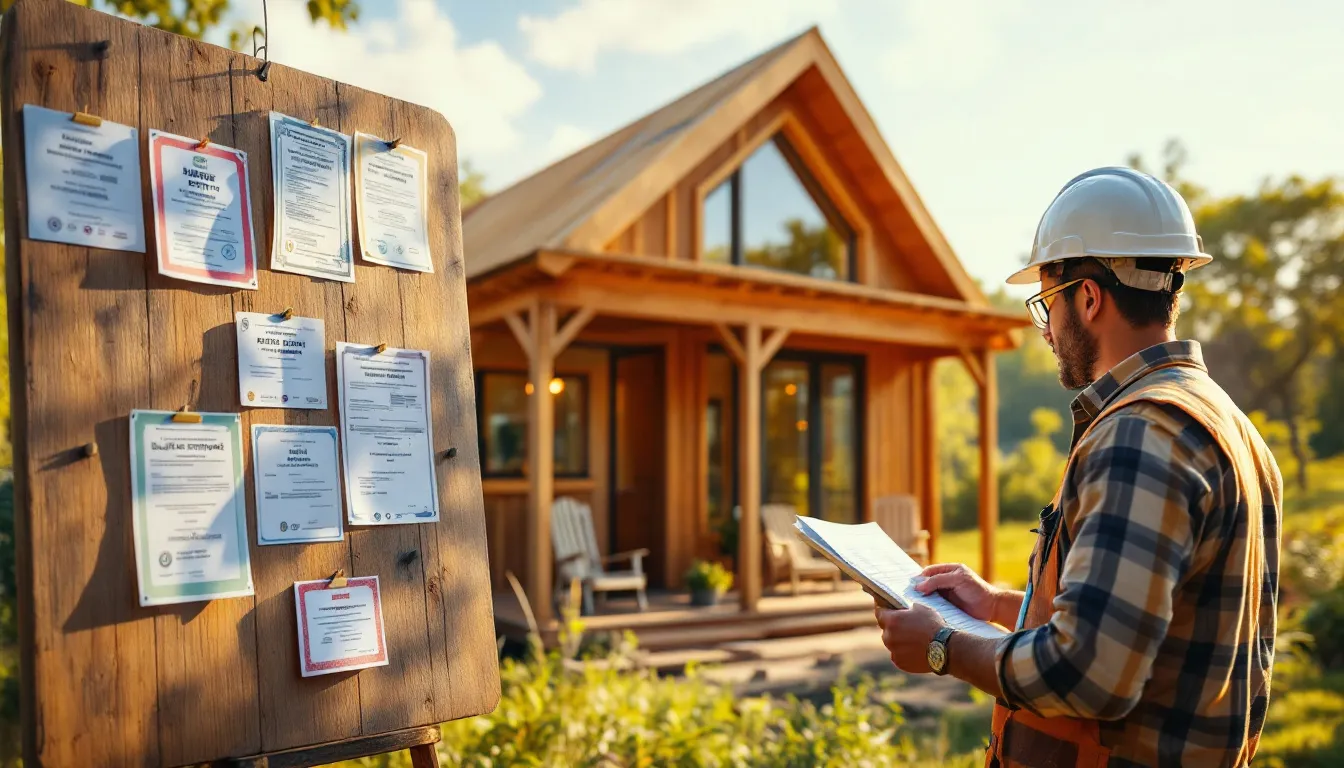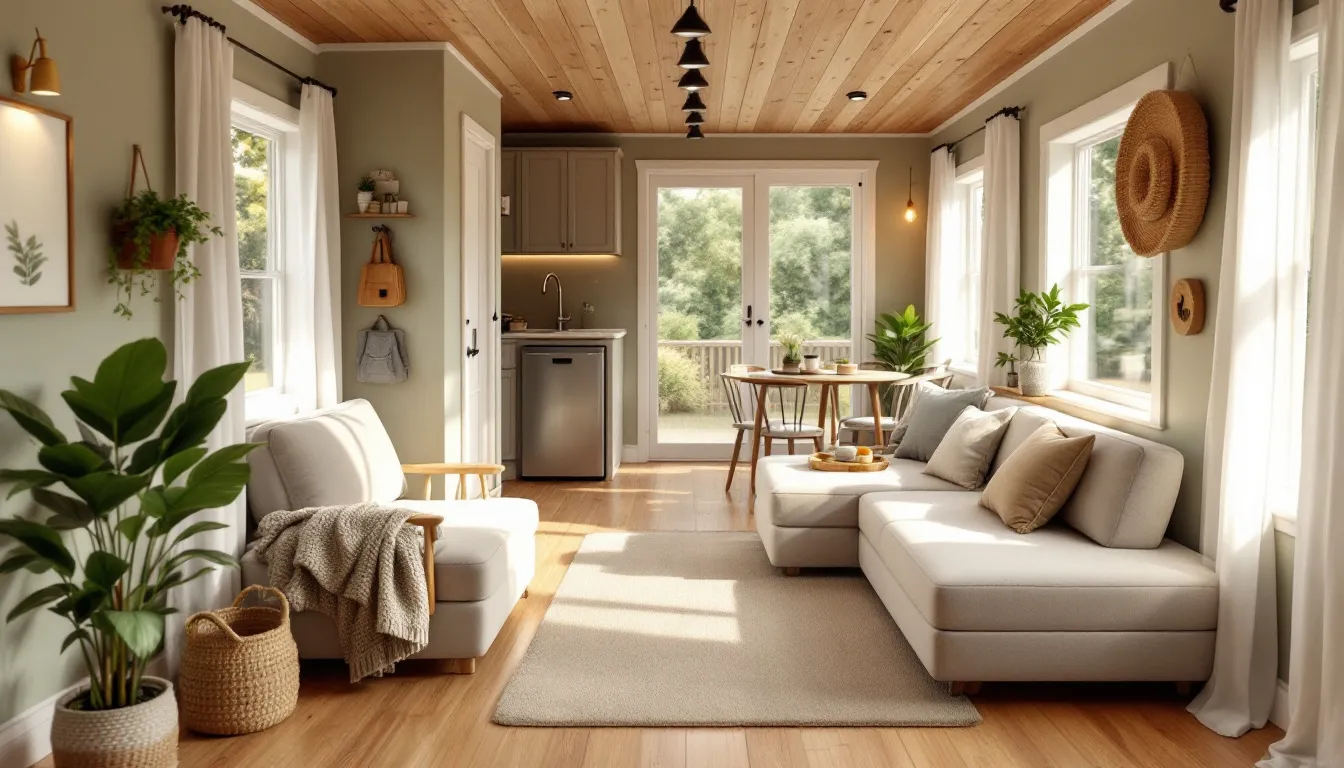Want to build a tiny house in Maine? Here's what you need to know:
- Maine allows tiny houses 70-400 square feet
- All counties permit tiny homes, but check local zoning rules
- Costs range from $50,000-$140,000 ($141/sq ft on average)
- Key challenges: storage, insulation, utilities
Quick facts:
- Maine passed LD 1981 in 2019, recognizing tiny houses as dwellings
- Tiny home communities are emerging (e.g. 34-unit project in Bangor)
- Rent in tiny home communities: $700-$1,200/month
Steps to build your tiny home:
- Research local regulations (2-3 months)
- Design your home (2-3 months)
- Get permits (4-6 weeks)
- Buy land if needed (1-2 months)
- Source materials (3-4 weeks)
- Hire contractors if not DIY (2-3 weeks)
- Build (timeline varies by season)
Remember: Always check with local zoning offices before settling on a location. Each town may have unique rules for tiny living.
This guide covers everything from laws and land setup to costs, building tips, and resources to help make your Maine tiny house dream a reality.
Related video from YouTube
Maine Laws and Rules
Maine's tiny house scene is booming, but the legal stuff can be a bit of a maze. Let's break it down so you know what's what when building your pint-sized paradise in Vacationland.
Maine's Tiny House Law LD 1981
In 2019, Maine passed LD 1981, and it was a big deal for tiny house fans. This law puts tiny houses on the map as legit single-family homes. Here's the scoop:
- Tiny house = 400 square feet max (not counting lofts)
- Must follow Maine Uniform Building and Energy Code (MUBEC)
- Applies to homes on wheels AND foundations
- State says yes, but local rules still matter
This law opened the door, but remember: your town might have its own ideas.
Local Rules and Building Codes
State law is cool with tiny houses, but your town might be a different story. Here's what to look out for:
- Zoning: Where can you park your tiny house? Ask your local planning office.
- Permits: Yep, you'll probably need one. Even for a tiny house.
- Utilities: Some places want you hooked up to the grid, others are okay with off-grid living.
Take Portland, for example. In 2020, they started allowing tiny houses in most residential areas. But they've got their own rulebook.
Getting Your Tiny House Registered
Got a tiny house on wheels? You'll need to jump through a few hoops:
- Title: It's basically an RV in the eyes of the law
- Registration: Head to the Maine Bureau of Motor Vehicles
- Inspection: Gotta make sure it's road-worthy
- Insurance: Not required by law, but you'd be crazy not to have it
This stuff can get complicated. If you're scratching your head, chat with a local tiny house pro or a lawyer who knows the ropes. They can help you stay on the right side of the law and avoid any nasty surprises.
Finding and Setting Up Your Land
Finding the right spot for your tiny house in Maine is key. Let's look at what you need to know about land rules, foundations, and utilities.
Land Rules
Before you buy land, check the local rules. They're different in each town. Here's what to look for:
- Can you even build a tiny house there? Some towns have size rules.
- How far does your house need to be from property lines and roads?
- Is there water, electricity, and sewer access?
- Can you use the road all year? This matters in rural Maine.
Types of Foundations
Your foundation choice is crucial, especially with Maine's tough winters. You've got two main options:
1. Permanent Foundations
These are like regular house foundations. They include:
- Concrete slabs
- Crawl spaces
- Full basements
2. Temporary Foundations
Better for tiny houses on wheels. Think:
- Pier foundations
- Screw piles
- Concrete blocks
Pick based on your soil, how deep the ground freezes, and local building codes. In Maine, you'll want a foundation that can handle freezing and thawing.
Setting Up Water and Power
Getting utilities to your tiny house is a big deal. Here's the scoop:
Water Supply:
- City water? Easy peasy.
- No city water? You might need a well. It'll cost you $3,000 to $15,000 in Maine.
- Rain collection can help, but don't count on it as your only source.
Power:
- Most folks connect to the grid. Call your local power company to find out how.
- Want to go solar? An off-grid system for a tiny house in Maine runs about $5,000 to $15,000.
- Think about a backup generator for those cloudy Maine days.
Sewage:
- City sewer is straightforward if it's available.
- No sewer? You'll need a septic system. In Maine, that's a $10,000 to $25,000 job.
- Composting toilets are an option, but check if they're allowed first.
Planning Your Build
Building a tiny house in Maine? Let's talk planning. It's crucial to get this right.
Size Limits
Maine's Tiny House Law (LD 1981) sets the stage: your living space can be up to 400 square feet, not counting lofts. Sounds small? You'd be surprised how roomy it can feel with smart design.
Floor Plan Basics
In a tiny house, every inch matters. Here's how to make the most of it:
Mix your living room, kitchen, and dining area. It'll feel bigger. Use furniture that does double duty - think beds that fold into walls and tables that collapse. And don't forget to look up - lofts are great for sleeping or stashing stuff.
Tiny Homes of Maine offers floor plans that squeeze every bit of usefulness out of your space. They're pros at fitting in smart storage and features that work well in Maine's climate.
Building Materials for Maine Weather
Maine's weather can be tough. Your materials need to be tougher:
- Insulation: Go for high R-value. It'll keep you cozy in winter and cool in summer.
- Roofing: Metal's a popular choice. It sheds snow and lasts ages.
- Siding: Fiber cement or vinyl can stand up to Maine's weather mood swings.
Corinne from Tiny Homes of Maine puts it well: "Our homes are built to handle Maine and New England's harsh winters." That local know-how? It's gold when you're picking materials.
One last thing: make sure your tiny home follows the rules. Look up American National Standards Institute standard A 119.5 and National Fire Protection Association standard 1192. They cover important stuff like plumbing, propane, fire safety, and more.
sbb-itb-2ef3f3a
Costs and Money Options
Building a tiny house in Maine can be cheaper than a regular home, but you need to know the costs and how to pay for it. Let's break it down.
What It Costs
The price of a tiny house in Maine depends on size, materials, and who builds it. Here's what you might pay:
- DIY Build: $30,000 to $40,000 for basic materials. Rebecca Neubauer built her tiny house in a 10x20 foot shed for $15,000 to $20,000, doing the work herself.
- Professional Build: $50,000 to $150,000. Tumbleweed's 161-square-foot "Elm" model costs $66,000.
- Land: In Maine, an acre averages $45,400, but prices vary a lot.
-
Utilities:
- Electrical: $3,000 to $12,500
- Plumbing: $500 to $3,000 (just labor)
- HVAC: $1,500 to $4,000
- Permits and Inspections: $500 to $2,500 for permits, up to $250 for inspections.
- Foundation: If not on wheels, $5,000 to $8,000.
Tiny homes cost more per square foot than regular houses - about $300 compared to $150.
How to Pay
Getting money for a tiny house can be tricky. Here are some options:
- Personal Loans: Up to $100,000, 7-year terms. Interest rates: 7.99% to 35.99% APR.
- RV Loans: For houses on wheels. 15-20% down payment, about 9% APR.
- Home Equity Loans or HELOCs: If you own a home. Home equity loans average 12.49%, HELOCs 15.51%.
- Builder Financing: Some builders offer this. Compare rates with other options.
- Savings: Many people save up and pay cash.
Cost Comparison
Tiny houses vs. regular homes in Maine:
- Tiny House: $30,000 to $70,000
- Regular Home: $382,580 (median price)
Cost per square foot:
- Tiny houses: $300 to $400
- Regular homes: $141.07 (not including land and permits)
Tiny houses cost less for utilities, upkeep, and taxes. Insurance is about $75 per month, much less than for a regular home.
Laura Lynch, a financial planner, says: "Financing a tiny home isn't a paved path. There's no specific mortgage product for tiny homes." So, look at all your options and think about long-term costs before you decide.
Help and Support
You don't have to tackle your Maine tiny house project alone. Here's where to find the help you need:
Builders and Inspectors
Maine's got some solid tiny house builders:
Tiny Homes of Maine in Dyer Brook: Family-owned since 2016. They're all about efficiency. Homes run $45,000 to $120,000.
Acadia Tiny Homes in Southwest Harbor: Eco-friendly is their thing. Expect to shell out $35,000 to $85,000.
Maine Mountain Tiny Homes in Farmington: Tough builds for mountain living. Prices? $50,000 to $90,000.
Need an inspector? Try these pros:
- Lloyd Cotton, LMC Home Inspections, Monmouth: (207) 240-4006
- David Brezack, Focused Property Inspections, Windham: (207) 839-6595
- Tana McNutt, Northland Home Inspection Service, Inc., New Limerick: (207) 532-3536
Don't skip the inspection. It's not just red tape - it's about making sure your tiny home is safe and up to code.
Local Stores and Groups
Forget the big box stores. Local lumber yards often have better wood and prices. Check out Hammond Lumber Company - they've got 21 spots across Maine.
Want to meet other tiny house folks? Look up the Maine Tiny House Meetup group. They're all about sharing tiny living know-how.
Online Resources
The internet's got your back:
- Tiny House Build: Free workshops and paid courses on building.
- Tiny House Nation: TV show with a website full of tips.
- Tiny Houses For Sale, Rent, and More: A goldmine for tiny house info. Find builders, communities, and learn about buying, building, and living tiny.
Building a tiny house? It's a big deal. But with these resources, you can make it happen in Maine.
Project Schedule
Building a tiny house in Maine? Let's map out your timeline.
Planning Steps
Before you start building, you need to plan:
1. Research and Design
Spend 2-3 months studying Maine's tiny house rules and designing your home. Maine allows tiny houses between 70 and 400 square feet.
2. Permitting
Set aside 4-6 weeks to get your permits. Check with your local zoning department - rules can vary by town.
3. Land Acquisition
Don't have land yet? Budget 1-2 months to find and buy a suitable plot.
4. Materials Sourcing
Take 3-4 weeks to source your materials. Consider local suppliers like Hammond Lumber Company for good prices and quality.
5. Contractor Hiring
If you're not DIYing, spend 2-3 weeks finding contractors who know tiny house construction in Maine.
Building Timeline and Weather
Maine's weather can throw a wrench in your plans. Here's how to work with the seasons:
Spring (April-June): Kick off construction. Mild weather means productive building.
Summer (July-August): Perfect for exterior work. Long days = more work time.
Fall (September-October): Finish the exterior before winter hits.
Winter (November-March): Move indoors. Expect delays from snow and cold.
Marc Bilodeau, a Maine tiny house builder, says:
"After 200 hours of construction, our exterior stayed mostly the same when winter hit. We moved inside and did phase 1 of electrical in 42 hours."
Matt Sluter, President of New England Construction, advises:
"Start your finishes in early spring. You'll save big on heating costs during Maine's harsh winters."
Move-in Checklist
Before you call it home, check these boxes:
- Get all required inspections (electrical, plumbing, structural)
- Make sure all utilities work
- Double-check insulation and sealing
- Test smoke detectors, carbon monoxide alarms, and fire extinguishers
- If it's cold, winterize to prevent plumbing issues
Plan smart, build efficiently, and enjoy your new tiny home in Maine!
Wrap-up
Building a tiny house in Maine? It's a big step towards simpler living. This guide has shown you the ins and outs, from planning to dealing with local rules.
Maine's pretty cool when it comes to tiny homes. They passed LD 1981, which treats tiny houses a lot like regular homes. That's opened doors across the state.
Here's what you need to know:
- Size: Your tiny home in Maine? It's gotta be 70 to 400 square feet. And don't forget - at least 6 feet 8 inches of headroom.
- Location: All Maine counties say yes to tiny homes. But local rules can be tricky. Always check with your local zoning office first.
- Money: Building a tiny house in Maine? Think $50,000 to $140,000. That's about $141 per square foot.
- Challenges: From storage to insulation, every inch counts. Plan smart.
Tiny home communities are popping up too. Take Bangor. Louie Morrison's building the city's first tiny home community. Started in June 2023, it'll have 34 tiny homes on two acres. Rent? $700 to $1,200 a month.
Nikitia Moore, who recently retired to a tiny home, says: "Living tiny? It's saved me money and time." Lots of tiny home folks feel the same way.
Building a tiny home isn't just about the house. It's about changing how you live. The Tru Form Tiny Team puts it well: "Building a tiny house is fun and rewarding. But watch out for those common mistakes."
So, ready to go tiny in Maine? It's a journey. But with the right planning and mindset, it could be the best move you ever make.
FAQs
Where can I put my tiny home in Maine?
Maine's pretty open to tiny homes. All counties allow them, but some towns are extra welcoming:
- Wiscasset
- New Gloucester
- Chelsea
- Stonington
- Hollis
- Old Orchard Beach
But here's the deal: ALWAYS check with local zoning offices before you settle on a spot. Each town might have its own rules for tiny living.
What counties in Maine allow tiny houses?
Here's some good news: ALL counties in Maine allow tiny homes. Yep, you read that right. This is thanks to LD 1981, passed in 2019, which says tiny houses are legit dwellings.
But don't get too excited just yet. Corinne Watson from Tiny Homes of Maine says:
"While all Maine counties allow tiny homes, some have stricter regulations. Always check local laws before building or placing your tiny house."
Smart advice, Corinne.
Which towns in Maine allow tiny homes?
Some Maine towns are really embracing the tiny house trend. Check these out:
- Wiscasset: This historic town's updated its zoning for tiny homes.
- New Gloucester: Most residential areas here are tiny-house friendly.
- Chelsea: Just outside Augusta, it's becoming a tiny house hotspot.
- Stonington: Want ocean views with your tiny home? This coastal town's got you covered.
- Hollis: Over in York County, Hollis is pretty tiny-house friendly.
- Old Orchard Beach: Beach life in a tiny home? Yes, please!
But here's the thing: even in these towns, you've got to play by the rules. There might be size requirements, utility connection rules, and building codes to follow.
Want the latest scoop on Maine's tiny house rules? Head over to Tiny Houses For Sale, Rent, and More. They've got a whole directory of tiny-house friendly spots and tips on navigating local zoning laws.



